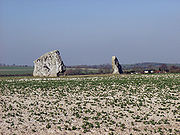
The Longstones
Encyclopedia

Cove (standing stones)
Cove is a term used to describe a tightly concentrated group of large standing stones found in Neolithic and Bronze Age England. Coves are square or rectangular in plan and seem to have served as small enclosures within other henge, stone circle or avenue features. They consist of three or four...
' of standing stone
Standing stone
Standing stones, orthostats, liths, or more commonly megaliths are solitary stones set vertically in the ground and come in many different varieties....
s close to Beckhampton in the English
England
England is a country that is part of the United Kingdom. It shares land borders with Scotland to the north and Wales to the west; the Irish Sea is to the north west, the Celtic Sea to the south west, with the North Sea to the east and the English Channel to the south separating it from continental...
county of Wiltshire
Wiltshire
Wiltshire is a ceremonial county in South West England. It is landlocked and borders the counties of Dorset, Somerset, Hampshire, Gloucestershire, Oxfordshire and Berkshire. It contains the unitary authority of Swindon and covers...
.
Two stones are visible, known as 'Adam' and 'Eve' although the latter is more likely to have been a stone that formed part of the Beckhampton Avenue
Beckhampton Avenue
The Beckhampton Avenue a curving prehistoric avenue of stones that ran broadly south west from Avebury towards The Longstones at Beckhampton in the English county of Wiltshire. It probably dates to the late Neolithic and early Bronze Age....
that connected with Avebury. The avenue probably terminated here although it may have extended further to the south west beyond the stones. William Stukeley
William Stukeley
William Stukeley FRS, FRCP, FSA was an English antiquarian who pioneered the archaeological investigation of the prehistoric monuments of Stonehenge and Avebury, work for which he has been remembered as "probably... the most important of the early forerunners of the discipline of archaeology"...
recorded the site in the eighteenth century when it was only partially destroyed and suggested it extended further although modern excavation and archaeological geophysics
Archaeological geophysics
Geophysical survey in archaeology most often refers to ground-based physical sensing techniques used for archaeological imaging or mapping. Remote sensing and marine surveys are also used in archaeology, but are generally considered separate disciplines...
have not confirmed this.
Adam is the larger of the two stones, weighing an estimated 62 ton
Ton
The ton is a unit of measure. It has a long history and has acquired a number of meanings and uses over the years. It is used principally as a unit of weight, and as a unit of volume. It can also be used as a measure of energy, for truck classification, or as a colloquial term.It is derived from...
s, and along with three others formed a four-sided cove. Excavations carried out jointly by the Universities of Leicester, Newport and Southampton University of Southampton
University of Southampton
The University of Southampton is a British public university located in the city of Southampton, England, a member of the Russell Group. The origins of the university can be dated back to the founding of the Hartley Institution in 1862 by Henry Robertson Hartley. In 1902, the Institution developed...
in 2000 revealed the socket holes for the other stones which were tightly placed close to Adam. The cove had been open on its south eastern side which faced towards the nearby South Street barrow
South Street barrow
The South Street barrow is a Neolithic long barrow in the English county of Wiltshire near Beckhampton.It lies around 130m south east of the cove of The Longstones and may therefore be connected with the Neolithic ritual landscape centred on Avebury.It was excavated between 1964 and 1966 by Paul...
130m away. The other stones were destroyed in the post-medieval period by a local landowner.
Adam fell over in 1911 and was re-erected (incorrectly) by Maud Cunnington
Maud Cunnington
Maud Edith Cunnington , was a Welsh-born archaeologist, most famous for her pioneering work on the prehistoric sites of Salisbury Plain....
in 1912. Cunnington also found a Beaker inhumation of a middle-aged man buried close by the stone which is considered to postdate the megalith.
- 51.422855 -1.873276

